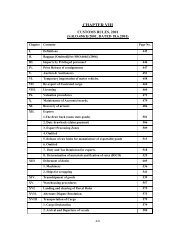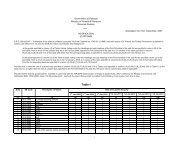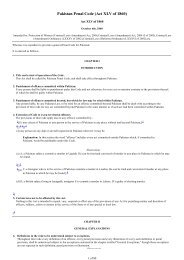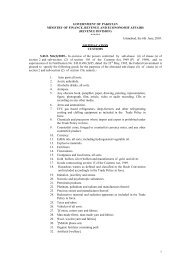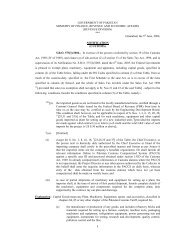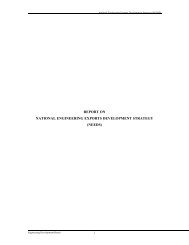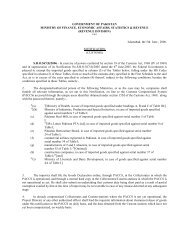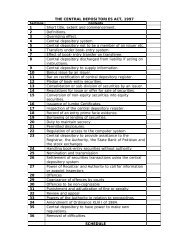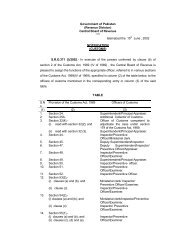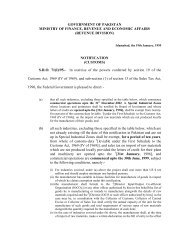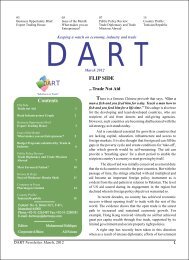47. Pakistan Economic Survey 2011-12 - Consultancy Services in ...
47. Pakistan Economic Survey 2011-12 - Consultancy Services in ...
47. Pakistan Economic Survey 2011-12 - Consultancy Services in ...
Create successful ePaper yourself
Turn your PDF publications into a flip-book with our unique Google optimized e-Paper software.
Social Safety NetsBox-1Poverty Alleviation and Millennium Development GoalsThe UNDP’s Human Development Report, <strong>2011</strong> ranks <strong>Pakistan</strong> at 145 th with HDI value of 0.504. The report showsgradual <strong>in</strong>crease <strong>in</strong> the value of HDI from 0.503 <strong>in</strong> 2010 and 0.499 <strong>in</strong> 2009, through <strong>Pakistan</strong>’s rank has slipped alittle dur<strong>in</strong>g <strong>2011</strong>. Other composite <strong>in</strong>dices place <strong>Pakistan</strong> at a lower rank. The Inequality Adjusted Poverty Index is0.346 and multi-dimensional poverty <strong>in</strong>dex for <strong>Pakistan</strong> is 0.264. These <strong>in</strong>dices weight <strong>in</strong>equality and non-<strong>in</strong>comedimensions of poverty more.<strong>Pakistan</strong> Social and Liv<strong>in</strong>g Standards Measurement <strong>Survey</strong> 2010-11 shows mixed results <strong>in</strong> terms of the educationenrolment <strong>in</strong>dicators. Literacy rate (10+) has improved from 57 percent <strong>in</strong> 2008-09 to 58 percent and adult literacyimproved from 54 percent to 55 percent <strong>in</strong> the same period, while Primary and Middle school Gross EnrollmentRate also registered a one percentage po<strong>in</strong>t improvement. However, slippage on the primary and secondary NetEnrollment Rate is an area of concern for policy makers, particularly after devolution of the subject to the prov<strong>in</strong>ces.Immunization of children also improved dur<strong>in</strong>g <strong>2011</strong>. The PSLM also reported trends <strong>in</strong> terms of the water supplyand sanitation <strong>in</strong>dicators. Whereas the sanitation situation at household level has registered an improvement (<strong>in</strong>terms of 66 percent of population us<strong>in</strong>g flush toilets compared to 63 percent <strong>in</strong> 2008-09), the access to dr<strong>in</strong>k<strong>in</strong>gwater to urban and rural population of <strong>Pakistan</strong> is 94 percent and 84 percent respectively, with an average of 87percent <strong>in</strong> <strong>2011</strong>.A committee of poverty experts has been constituted <strong>in</strong> Plann<strong>in</strong>g and Development Division to estimate PovertyHeadcount as well as poverty correlates. The committee is work<strong>in</strong>g on its task <strong>in</strong> a professional ways consider<strong>in</strong>g alldimensions of poverty and report of the committee will be available shortly.Source: Plann<strong>in</strong>g & Development DivisionProfile of Consumption ExpenditureThe trends <strong>in</strong> household consumption expenditureprovide an effective <strong>in</strong>sight <strong>in</strong>to understand<strong>in</strong>g thedynamics of poverty <strong>in</strong> the country. Table-15.2reveals the per capita consumption expenditure <strong>in</strong>urban/rural areas and by qu<strong>in</strong>tiles. The average percapita expenditures for the richest class <strong>in</strong> theurban areas are more than four and half times thoseof the poor class. Analysis along similar l<strong>in</strong>es forrural areas <strong>in</strong>dicates that these averages are morethan three and half times those of the poor class.The average per capita expenditure is almost thesame for poor <strong>in</strong> rural and urban areas whereas forthe rich class it is higher <strong>in</strong> urban areas than <strong>in</strong> therural areas, <strong>in</strong>dicat<strong>in</strong>g that more wealth isconcentrated <strong>in</strong> urban areas compared to ruralareas.Table-15.2 Per Capita Monthly Household Consumption Expenditure by Qu<strong>in</strong>tiles & RegionPer Capita Monthly Household Consumption ExpenditureQu<strong>in</strong>tiles2007-08 2010-11Urban Rural Total Urban Rural Total1 st 906 868 874 1441 1426 14282 nd <strong>12</strong>16 <strong>12</strong>08 <strong>12</strong>10 1985 1966 19703 rd 1547 1522 1529 2469 2468 24684 th 2032 1998 <strong>2011</strong> 3217 3195 32035 th 4334 3566 3984 6679 53<strong>12</strong> 6073Ratio of highest to lowest 4.78 4.11 4.56 4.63 3.73 4.25qu<strong>in</strong>tilesSource: Federal Bureau of StatisticsTable 15.3 compares the percentage of monthlyconsumption expenditure by commodity groups.The consumption expenditure pattern for differentcommodity groups shows consistent trend from2007-08 to 2010-11. The share of food expenditureis relatively higher compared to the other223



